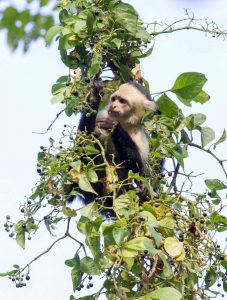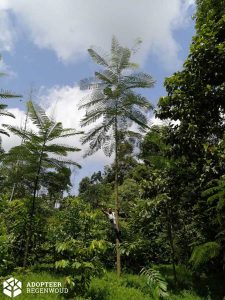From pasture to a fully-fledged rainforest

By: The program manager
Is it possible to restore the original rainforest in a deforested area where cows have been grazing for years? In Costa Rica at least they accept the challenge. This article tells in short how Work with Nature in Costa Rica is trying to transform degraded land back into a fully fledged rainforest.

Why reforestation
It is obviously more important to preserve existing rainforest by protecting it instead of planting new trees. If no trees are cut down, the need to plant them would also be much smaller. The Work with Nature foundation therefore consciously chooses to protect as much rainforest as possible and only plant new trees where necessary.
It has chosen to reforest only areas that are strategically important. The main reason is to enable migration for plants and animals. Animals avoid meadows to migrate, because of the risks it entails due to lack of shelter. The same animals are also the ones who have to spread the seeds of trees and plants, almost all seed distribution in the rainforest is done by animals. In contrast to the Netherlands where a lot of seed dispersal is done by the wind.
The jaguar
So it is important to get back to the original forest where rainforest was cut down in the past. The mission is to fully protect an area of 2000 hectares of continuous rainforest and restore it where necessary so that plants and animals can move and reproduce freely again. A good example is the Jaguar that needs at least 2000 hectares of continuous rainforest to survive. This feline is a key species for the rainforest, a species that ensures that animal life remains in balance. If the jaguar can survive in the area then this is a good indication that the rainforest is healthy and diverse enough.
But how do you get the original forest back to these important strategic places?
Theoretically, you could just wait. If you wait long enough and don't let any more cattle graze, then bushes and eventually forests will come again. Probably it will indeed become forest, but that could take a few human lives. In practice, few tree seeds end up in the meadows, because of the absence of seed spreaders (animals). And if a single tree seed ends up in the meadow there are few that can cope with the stiff high grass. The grass is so long and thick that sunlight can barely reach the ground and the grass also develops an enormous root mass in which almost no tree seed can germinate.
In order to speed up this process and perhaps create rainforest again within one lifetime, the biologists at Work with Nature thought of something else. The final tree species we want to have in our rainforest are those that occur in the rainforests around the deforested plots. However, these are species that you can't just plant and water in a meadow in the hope that they will grow. The "valuable" tree species (climax species), species that have a high natural value because they are important for a lot of life in the rainforest, are trees that can only grow in shade and a good forest climate. And not on a meadow in bright sunshine.
 The creation of a forest climate
The creation of a forest climate
In order for these ultimate target species to grow again, it is therefore important that a forest climate is created where there is sufficient shade. Previous studies in the high mountains of Costa Rica have shown that when you plant trees you can create a forest climate to stimulate natural rejuvenation.
To create this forest climate, 14 indigenous tree species have been selected (species that occur naturally in Costa Rica). There is chosen for fast growing tree species that preferably bear fruit. In this way you not only create a forest climate and shade as quickly as possible, but you also attract animals from the existing rainforest to these planted fruit-bearing trees. These animals are the key to success. If they feel comfortable to move freely in the reforested area again, they will ensure that the desired tree seeds from the rainforest will end up in the desired plot again. The planted trees provide an ideal climate and enough shade for these seeds to germinate. This allows them to grow into the desired "valuable" trees that will eventually create a fully-fledged rainforest.
Man and animal work together
It is still too early to draw conclusions. But there is good hope that with the help of some human input and the important contribution of rainforest animals, the succession of pasture to an adult rainforest is accelerated. And that eventually the area of 2000 hectares will be a fully interconnected rainforest, where the majestic Jaguar can roam freely and raise her young.
Want to read more about Costa Rica and her history, then go to:
